A Crucial Component: The Freehub
It’s easy to overlook the importance of the freehub, a small but essential part of most bicycles. This unassuming component plays a vital role in transmitting your pedal power to the road or trail, allowing your legs to take a break while you continue to move forward.
While many riders simply install a freehub and forget about it, there is actually a lot happening beneath its surface. Hidden away inside are complex mechanical parts that occasionally require some tender care to ensure optimal functionality.
When it comes to replacing your bike’s cassette, sticking to a like-for-like swap may seem simple enough. However, freehub compatibility is more intricate than it appears.
Understanding the Freehub
The freehub is represented by the silver section in the accompanying image. It serves as an extension of the right-hand side of the rear wheel’s hub. For bicycles equipped with derailleur gears, the freehub allows you to coast, keeping you moving without the need to pedal.
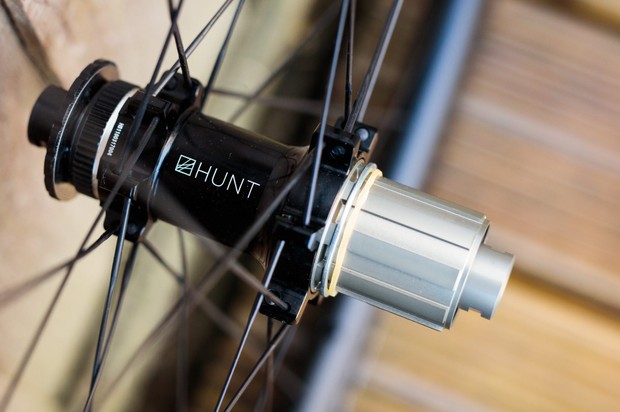
When you pedal, the freehub engages with the wheel, propelling you forward. Conversely, when you stop pedaling, the freehub disengages, allowing the wheel to rotate independently of the gears and pedals. The freehub body contains a mechanism that facilitates this engagement and disengagement process.
The splines on the freehub body play a crucial role in aligning the cassette with the wheel. During assembly, the cassette, consisting of individual sprockets or clusters, slides onto these splines, ensuring proper alignment.
Types of Freehub and Cassette Compatibility
While the concept of the freehub may seem straightforward, it’s important to delve into the various types available and explore their compatibility with different cassettes.
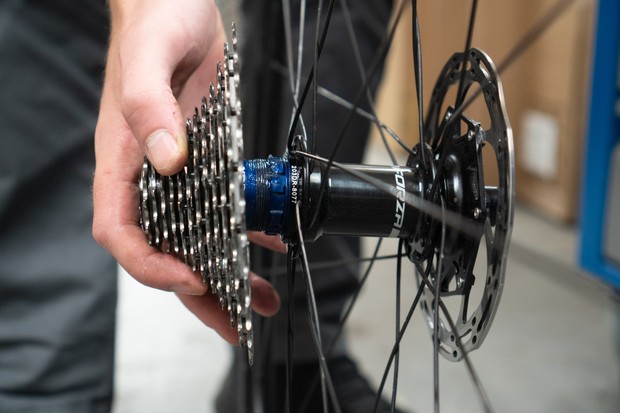
The amount of sprockets on the cassette is commonly known as its speeds. To give you an example, the latest road bike groupsets and mountain bike groupsets have 11 or 12 cogs on the back. These groupsets can be found here and here.
The sprockets are typically held securely in place by a lockring that threads into the end of the freehub, although there are exceptions which we will explain further.
Points of engagement and angle of engagement
Some brands mention points of engagement, while others refer to the angle of engagement when discussing their hubs. Points of engagement represent the number of distinct positions in which the freehub can lock to the wheel within a full revolution of the wheel, once you cease freewheeling and begin to pedal.
Since a complete revolution of the wheel is 360 degrees, the angle of engagement can be calculated by dividing 360 by the number of points of engagement.
For instance, if a freehub has 36 points of engagement, the angle of engagement would be 360/36 = 10 degrees. If there are 72 points of engagement, the angle of engagement would decrease to 5 degrees.
How a freehub operates
The majority of freehubs employ either a pawl or ratchet system to engage the freehub with the wheel when pedaling and disengage it when freewheeling.
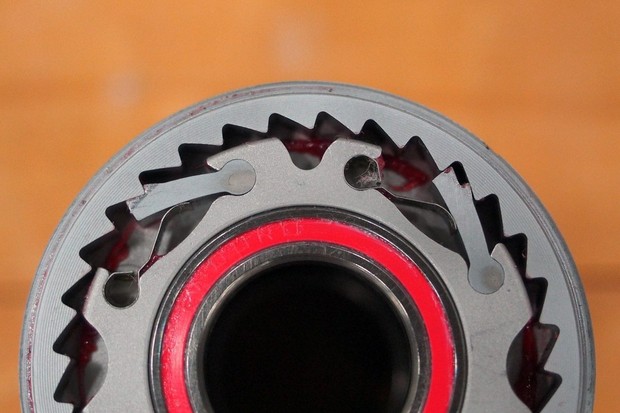
Within each system, there are various engineering variations, including well-known specialized designs such as Chris King hubs.
In the following sections, we will describe both systems and assess their respective advantages and disadvantages.
Types of freehubs
Pawl freehubs
A pawl freehub utilizes spring-loaded levers that mesh with a toothed drive. In one part of the bike’s hub, there are several angled outwardly sprung levers, known as pawls, which interlock with a toothed drive ring in the other part of the hub. This mechanism facilitates the transmission of power to the wheel.
Understanding Freehubs: How Springs and Pawls Work
The springs in a freehub play a crucial role in the function of the pawls. When you pedal, these springs push the pawls outward from their housings. However, the interesting part happens when you freewheel. Due to the angle of the pawls, they are pushed back against the springs and smoothly slide over the teeth, resulting in that distinctive clicking sound.
It’s important to note that the number of pawls can vary in different freehub designs, ranging anywhere from two to six. Generally, the pawls are located in the freehub and are pushed outward to engage with the teeth in the hub. However, there are also designs where the pawls are positioned on the inside edge of the hub flange, facing inwards towards the teeth on the freehub. Similarly, some hubs have the pawls placed on the center of the hub body, meshing with the teeth on the outer edge of the freehub, like the ones found in Mavic wheels.
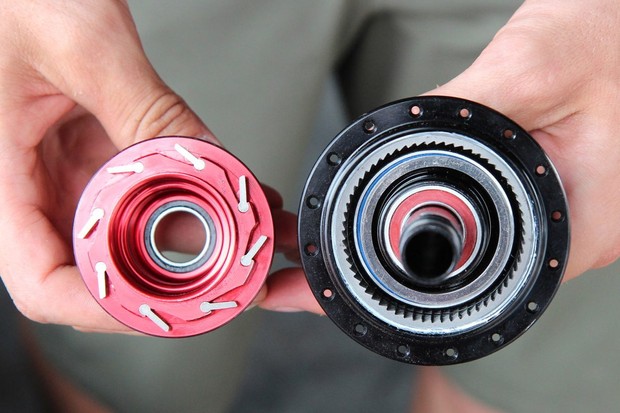
Having more pawls means more points of engagement, which can be advantageous for certain riding styles. A high number of engagement points, resulting in a smaller angle of engagement, is often desirable. To achieve this, manufacturers increase the number of teeth on the drive ring. However, this requires smaller teeth and pawls. Some brands tackle this challenge by using pawls with multiple teeth to distribute the load evenly, or by offsetting the pawls in a multi-phase configuration, allowing them to engage sequentially and reducing the angle of engagement.
Halo freehubs take a different approach by utilizing multiple teeth, resulting in an impressive 120 points of engagement. Unlike the usual flat profile, the pawls in these freehubs are wedge-shaped. This unique design ensures that the pedaling force pushes the pawls harder against the teeth in the hub, enhancing overall performance.
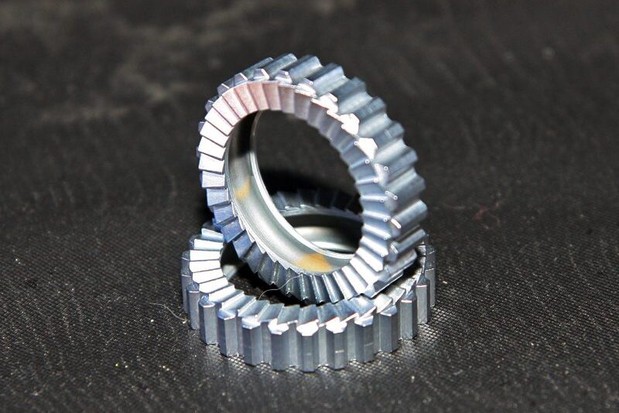
It’s worth noting that the pawls in a freehub endure significant force as they transmit all your pedaling torque. Regular maintenance is crucial, especially if you ride in wet or dirty conditions or if your wheels haven’t been used for some time.
Ratchet Freehubs: A Different Mechanism
In contrast to the springs and pawls system, ratchet freehubs utilize a pair of inter-connecting rings with teeth on their inner faces. These rings are concentric around the axle and are brought together to transfer the pedaling force to the rear wheel. Typically, large springs encircle the freehub and press the two ratchet rings firmly against each other, ensuring smooth power transmission.
By understanding the inner workings of both spring and pawl freehubs and ratchet freehubs, you gain insight into the fascinating mechanisms that enable your bike to perform optimally.
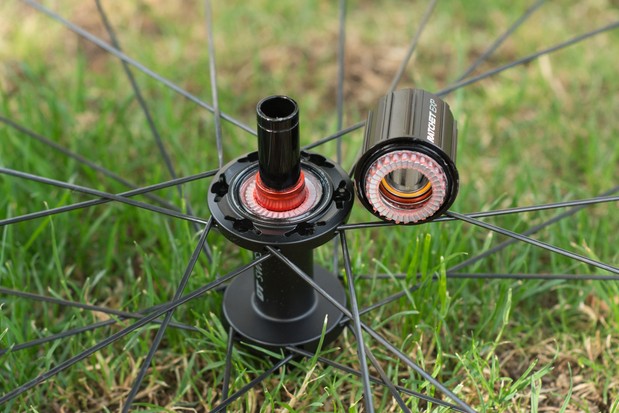
Understanding Ratchet Systems in Freehubs
One or both of the ratchet rings have the ability to slip in and out on the freehub using splines that are machined into their outer edges. These splines mesh with teeth in the freehub and/or hub body.
The teeth on the ratchet are angled, allowing the angled faces of each ring to slip over each other during freewheeling. They slide against the force from the springs. However, when you pedal, the flat faces of the rings mesh with one another to transmit your driving force to the wheel.
The DT Swiss Ratchet System
DT Swiss freehubs are all now based on the ratchet system and offer a range of 18 to 54 points of engagement. Some freehubs even allow you to replace the ratchets in order to adjust the number of points of engagement.
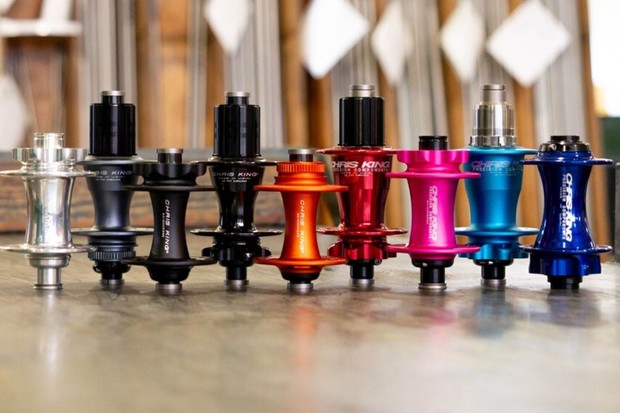
In the standard DT Swiss Ratchet system and the entry-level Ratchet LN, both ratchets can move within the hub and are pushed together by springs.
An Enhanced Ratchet System: Ratchet EXP
In the newer Ratchet EXP design, one of the ratchet rings threads into the wheel hub, while the second ring slides in and out on splines within the freehub. This allows it to engage or disengage the freewheel, and it is pushed by a single spring. This system is lighter and is usually utilized in DT Swiss’s high-end wheels.
The Chris King ‘RingDrive’ System
Another notable ratchet system is employed by Chris King hubs, which is referred to as the ‘RingDrive’ system. Chris King Components offers ratchet systems with either 45 or 72 points of engagement, resulting in ultra-fast take-up when you start pedaling. With this design, it is the inboard ratchet that slides on the hub to engage the freewheel, giving Chris King hubs their distinctive bulge on the right side.
Chris King’s Ratchet System
Chris King’s innovative ratchet system sets itself apart from DT Swiss’s hubs by utilizing angled splines in the hub, providing a unique advantage over the conventional straight in and out splines. As you apply more force to your pedal strokes, the two ratchets within the system are compelled to interlock with greater strength, greatly reducing the chance of slippage. In fact, Chris King proudly states that their system can withstand torque loads up to three times higher than some of their competitors.
Zipp’s Ratchet System
Zipp, a well-known brand, also incorporates a ratchet system into their premium Cognition hubs that accompany their NSW wheels. These hubs feature a 36-tooth ratchet system. Rather than relying on a spring mechanism, Zipp’s design employs six powerful magnets to push the inboard ratchet ring outward within the hub, engaging it with the ratchet in the freehub.
Pawl vs. Ratchet
When comparing pawl freehubs to ratchet-based systems, it becomes evident that pawl systems have a limited number of contact points between the ends of the pawls and the meshing teeth. On the other hand, ratchet systems offer a greater number of contact points spread in a ring around the inside of the freehub. Theoretically, ratchet systems provide increased reliability and improved force transmission. However, it’s important to note that well-engineered pawl systems rarely encounter issues if properly maintained.

Pawl systems do carry a higher risk of wear due to their smaller number of mating surfaces compared to the intricate intermeshing teeth found in ratchet systems. If one of the pawls fails or fails to engage effectively, there is an increased likelihood of damage to the freehub’s internal components and potential failure.

Engagement Angle Considerations
In certain scenarios, a smaller engagement angle is advantageous for quicker pedal take-up, especially during off-road climbing. However, on full-suspension mountain bikes, this can intensify kickback, where the suspension compression pulls the chain and cranks backward, placing additional strain on the freehub’s internal mechanisms and potentially causing failure.
While ratchet systems may appear to be the logical choice for high-stress applications, the priority of engagement angle may lead to the preference of an offset pawl system. Industry Nine’s Hydra freehubs utilize six offset pawls combined with a 115-tooth drive ring, resulting in an impressive 690 points of engagement and a remarkable angle of just over half a degree.
Freehub Bearings
In the realm of freehubs, ceramic bearings may be utilized by some, while steel bearings are the more common choice. Typically, a freehub rotates on its own sealed bearings and often includes inboard and outboard bearings to handle the load. This is in addition to the bearings found within the wheel axle. However, DT Swiss takes a unique approach by relocating the right-hand wheel bearing to sit inside the inboard ratchet of their Ratchet EXP hubs, effectively sharing the load and providing enhanced support.
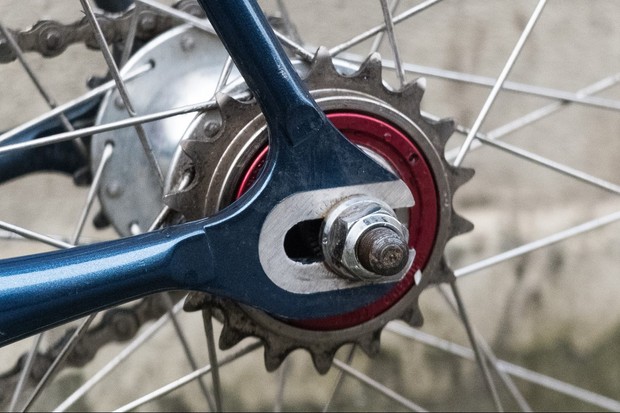
Cartridge bearings are relatively easy to replace compared to loose bearings. You can replace cartridge bearings on most freehubs, but certain brands like Shimano and Campagnolo use loose ball bearings that are sealed within the freehub body.
When it comes to Shimano freehubs, they can be serviced to some extent. However, once they’re worn out, you’ll need a completely new freehub, as they’re not designed to be disassembled, despite the fact that it is technically possible. On the other hand, freehubs from Campagnolo and other brands are simpler to service.
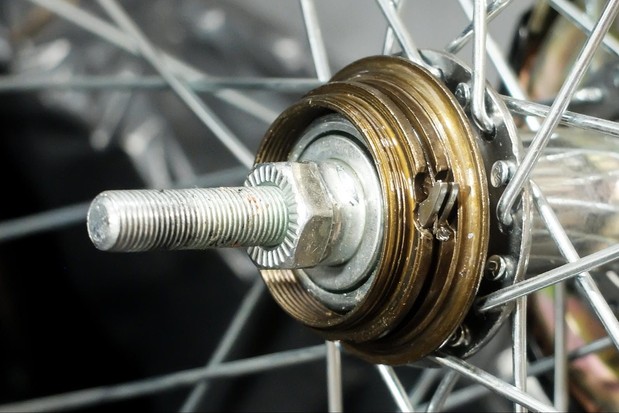
While many wheels are equipped with steel bearings, higher-end wheels occasionally utilize ceramic bearings for their perceived performance advantages. These ceramic bearings can be found in certain expensive wheels.
Understanding the Difference: Freehub vs Freewheel
When discussing bicycle components, you’ll often come across the term “freewheel.” Unlike a freehub, a freewheel has its ratchet mechanism integrated into the set of sprockets rather than being part of the wheel’s hub. To illustrate this, take a look at the image below, which showcases a freewheel on a singlespeed bike.
Freewheels are screwed onto the hub, in contrast to cassettes that slide onto freehub bodies. To attach the freewheel, a special tool is used to engage with slots in the freewheel’s body, securely fastening it to the threaded part of the hub. This ensures a rigid connection between the freewheel and the hub.
Freewheels existed before freehubs. They can still be found on older bicycles and the majority of modern singlespeed bikes. However, on multi-speed bikes, they have been replaced by the freehub because it is lighter and more compact, allowing for smaller sprockets and wider gear ranges.
Freehubs position the bearings further outward, reducing the likelihood of axle bending.
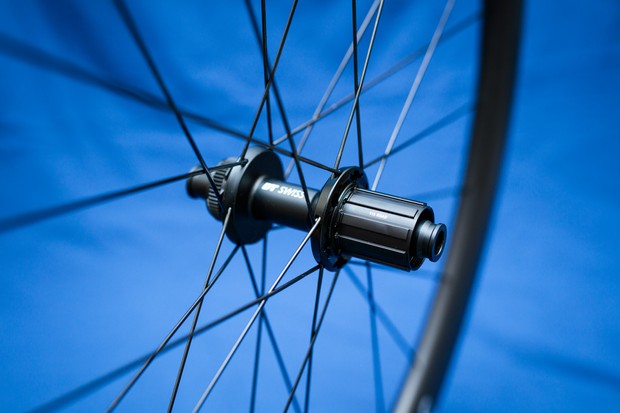
When changing a freewheel, you discard the ratchet each time, while with a freehub system, you keep the ratchet when swapping the cassette.
The Standards of Freehubs
Now that we have examined the internal components of the freehub, let’s focus on the external part where the cassette is mounted.
Different drivetrain manufacturers, such as Shimano, SRAM, and Campagnolo, employ various standards. Additionally, there are separate standards for mountain bike and road bike freehubs.
Some standards are compatible with each other, but many are not, even if they are designed for the same number of sprockets. Therefore, understanding the type of freehub you have or need is crucial when changing a cassette, swapping the freehub, or purchasing a new wheelset.
Shimano Hyperglide
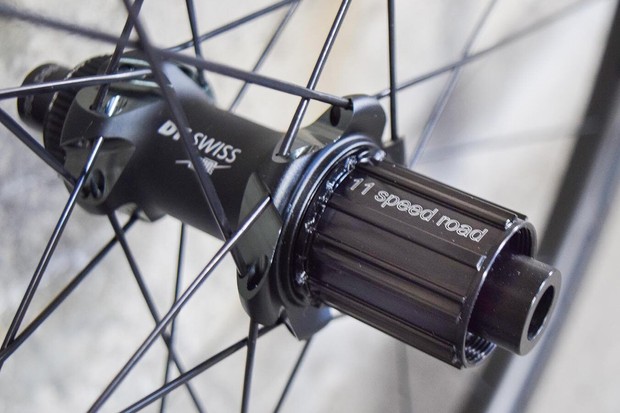
Shimano Hyperglide is a widely-used freehub design. It features raised splines on the outer surface of the freehub body, which correspond to slots on the cassette sprockets.
Two of these splines have a different width and spacing compared to the rest. This ensures that the sprockets cannot be mounted incorrectly or in the wrong position.
Modern Hyperglide freehub bodies are compatible with 11-speed Shimano/SRAM-compatible cassettes designed for road bike wheels.
Compatibility between Freehub Bodies and Speeds
Many freehub bodies offer compatibility across different speeds. This means you can use Shimano-standard cassettes with 8, 9, or 10 speeds. However, if you want to use a 10-speed cassette, you’ll need to fit a 1.85mm spacer on the inboard side of the cassette. Additionally, for 10-speed cassettes, you’ll require an additional 1mm spacer.
If you want to run an MTB cassette on an 11-speed road freehub, you’ll also need to use a spacer. This is because Shimano/SRAM MTB freehubs are slightly narrower than 11-speed road freehubs.
Before the introduction of 11-speed cassettes, Hyperglide freehubs were shorter and usually accepted 8, 9, or 10-speed cassettes. However, 10-speed cassettes required a spacer. It’s worth noting that certain Shimano wheels and hubs were equipped with 10-speed-only freehubs, which were not compatible with other speeds.

Shimano’s Hyperglide Freehub Design
With Shimano’s transition to 12-speed in its latest Dura-Ace Di2 R9200 groupsets, the company has updated its Hyperglide freehub design. The width of the splines has been reduced while the number of splines has been increased. This modification enhances the surface area and reduces the likelihood of sprockets ‘biting’ into the freehub body.
Cassettes from the Ultegra R8100 series still use the same 11-speed HG freehub as the previous generations.
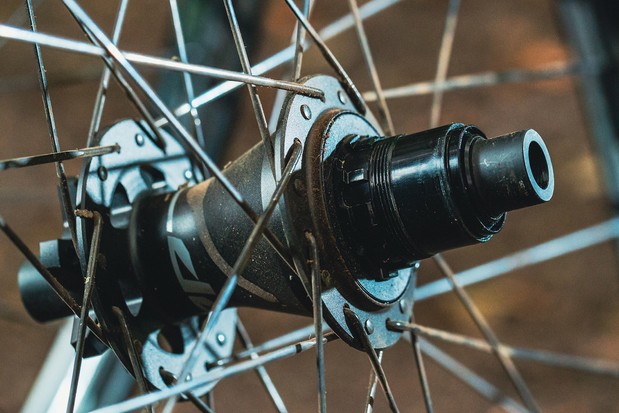
Shimano Micro Spline
The Shimano Micro Spline, designed for use with the brand’s 12-speed MTB cassettes, provides the freedom to utilize alloy instead of steel for the freehub body. Featuring 23 splines, the Micro Spline hub closely resembles the ones found on the new 12-speed road freehub.
However, the design of Micro Spline allows cassettes to have a smaller sprocket of 10 teeth instead of the 11 teeth smallest sprocket that Hyperglide can handle.
Although they may appear similar, Shimano’s new 12-speed Dura-Ace freehubs and Micro Spline are distinct, and cassettes cannot be swapped between the two systems.
SRAM XD
The SRAM XD system, sometimes referred to as “XD drivers,” was initially created to accommodate mountain bike cassettes with a smallest sprocket of 10 teeth. It features a shorter body compared to a standard 11-speed Shimano/SRAM freehub.
The cassette is connected to the freehub through a combination of short splines and a threaded area on the freehub body.
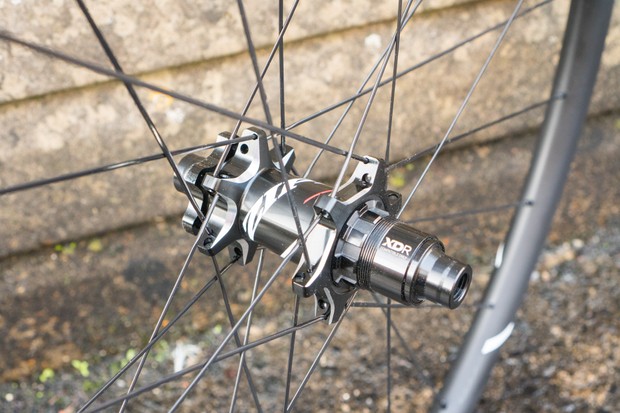
When installing a new cassette, it is important to ensure the splines in the cassette align with the freehub and then securely tighten the cassette onto the threads using a standard cassette tool. This design eliminates the need for a separate lock ring.
An XD freehub is often referred to as an XD driver, as they mean the same thing.
SRAM XDR
The SRAM XDR freehub is wider than SRAM XD. It operates in the same manner and follows the XD standard, but it is 1.85mm broader to accommodate the 12-speed road cassettes used in its eTap AXS wireless electronic groupsets.
Its additional width allows you to install a SRAM XD MTB cassette on an XDR freehub by adding a 1.85mm spacer inside the cassette. However, this means that you cannot fit an XDR cassette onto a mountain bike wheelset that has an XD freehub body.
Campagnolo FW
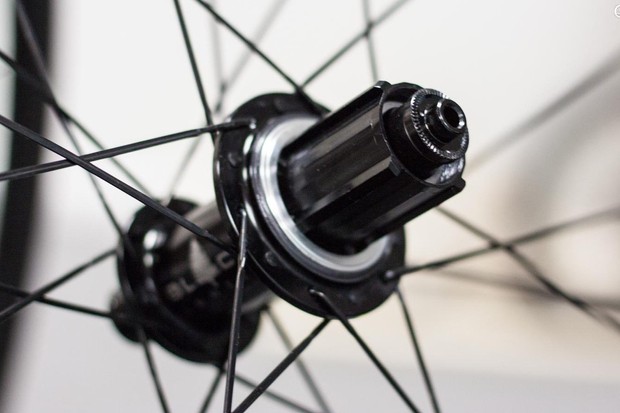
Campagnolo freehub bodies are seldom seen. Oli Woodman / Our MediaA standard Campagnolo freehub is only compatible with Campagnolo cassettes because it has deeper splines compared to a Shimano/SRAM freehub body.
Similar to Shimano/SRAM, there is differential spline spacing to ensure that you can only mount the individual cassette sprockets in one specific position and orientation. It also uses a different lock ring that is not compatible with Shimano’s, as it is used to secure the cassette on the freehub.
Campagnolo utilizes a single freehub design that accommodates 9-, 10-, 11-, and 12-speed cassettes. The newest N3W freehub also accepts 13-speed cassettes.
Campagnolo N3W
The N3W freehub, shown above, is a shortened version of Campagnolo’s existing road design. Matthew Loveridge / Immediate MediaCampagnolo’s latest N3W freehub body standard is specifically designed for compatibility with the Campagnolo Ekar gravel bike groupset. It is 4.4mm shorter than an FW freehub body, making it slightly lighter, but it retains the same splines pattern.
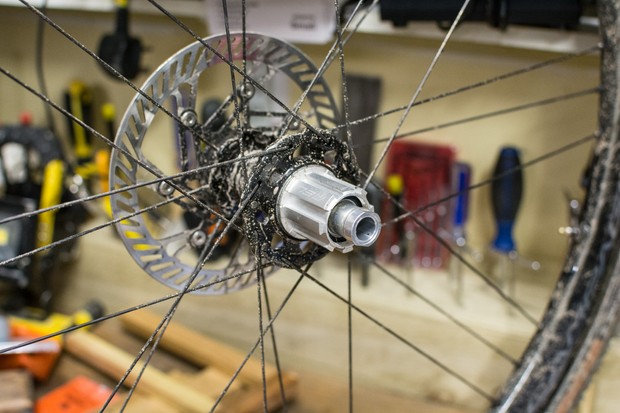
The shorter body allows Campagnolo to offer 13-speed Ekar cassettes with sprockets as small as nine teeth, providing a wide range of options with its 9-36, 9-42, or 10-44 tooth cassette choices.
The good news is that the N3W freehub is backwards-compatible with Campagnolo’s standard road-going cassettes through an adapter that can be attached to the end of the N3W freehub body. Campagnolo states that its future wheelsets will come with an N3W freehub body as the standard option.
Freehub compatibility
Installing and removing the freehub is a simple and straightforward process. Russell Burton / Immediate MediaFrom the information provided above, it is evident that there are opportunities to use certain freehubs with cassettes they were not specifically designed for, usually by utilizing spacers to achieve the required additional width for fitting a narrower cassette onto a wider freehub.
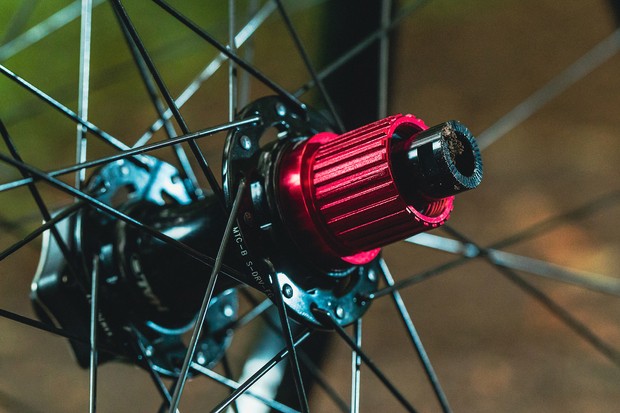
However, the opportunities to extend a freehub to accommodate a wider cassette are more limited, with only the Campagnolo N3W system offering an adapter for such purposes.
Many wheelset manufacturers offer wheels with different freehub standards available as options, allowing you to choose a wheelset that is compatible with the type of cassette you intend to use.
Although some wheelsets only offer a single freehub option, it is becoming increasingly common to purchase a separate freehub that matches your wheels and allows you to switch standards.
How to service a freehub
Servicing a freehub is a simpler task than it may initially appear. Jack Luke / Immediate MediaWe have a comprehensive article on how to properly service a freehub. While it may be one of the more intricate maintenance tasks for bicycles, it is certainly within the capabilities of a home mechanic.

Some freehubs are designed to be easily removed from the wheel without requiring any tools, while others may necessitate specialized tools. DT Swiss freehubs, for example, require a specific set of tools for disassembly, whereas some others can be accessed with a standard set of Allen keys.
When servicing your freehub, it is important to keep track of the numerous small parts involved, especially in pawl-based systems. Therefore, working in a systematic and attentive manner is crucial.
Furthermore, it is essential to use the appropriate lubrication when reassembling your freehub. Using heavy grease can cause the internal components to become sticky and potentially lead to the failure of the freehub. Most hub manufacturers recommend using their own lightweight lubricants.








